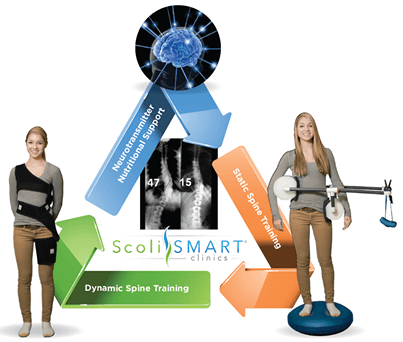Types of idiopathic scoliosis are categorized by both age at which the curve is detected and the location of the curve.
When grouped by age, scoliosis usually is categorized into three age groups:
- Infantile scoliosis: from birth to 3 years old
- Juvenile scoliosis: from 3 to 9 years old
- Adolescent scoliosis: from 10 to 18 years old
Adolescent scoliosis occurs in children age 10 to 18 years old, and comprises approximately 80% of all cases of idiopathic scoliosis. This age range is when rapid growth typically occurs, which is why the detection of a curve at this stage should be monitored closely for progression as the child’s skeleton develops.
Terms Used to Describe Spinal Curvature
Scoliosis curves are often described based on the direction and location of the curve. Physicians have several detailed systems to classify specific curves, but here are some common terms used to describe scoliosis:
Terms that describe the direction of the curve:
- Dextroscoliosis describes a spinal curve to the right (“dextro” = right). Usually occurring in the thoracic spine, this is the most common type of curve. It can occur on its own (forming a “C” shape) or with another curve bending the opposite way in the lower spine (forming an “S”).
- Levoscoliosis describes a spinal curve to the left (“levo” = left). While common in the lumbar spine, the rare occurrence of levoscoliosis in the thoracic spine indicates a higher probability that the scoliosis may be secondary to a spinal cord tumor. A physician will order an MRI for a thorough diagnosis.
Terms that describes the location of the curve:
- Thoracic scoliosis is curvature in the middle (thoracic) part of the spine. This is the most common location for spinal curvature.
- Lumbar scoliosis is curvature in the lower (lumbar) portion of the spine.
- Thoracolumbar scoliosis is curvature that includes vertebrae in both the lower thoracic portion and the upper lumbar portion of the spine.
Using directional and locational terms together, physicians can accurately describe specific curves. Two typical examples include:
- A C-shaped curve described as thorocolumbar dextroscoliosis refers to a single curve that spans the lower thoracic and upper lumbar vertebrae.
- An S-shaped curve described as thoracic dextroscoliosis and lumbar levoscoliosis indicates that there are two curves of which the upper curve is located in the thoracic spine and leans to the right, and the bottom curve is in the lumbar spine and leans to the left.
Other Types of Scoliosis
The most commonly known type of scoliosis is idiopathic scoliosis. Other types of scoliosis include:
- Congenital scoliosis, which develops in utero and is present in infancy. A rare condition, affecting one in 10,000, there is no known cause, but in most cases the spinal curve must be corrected surgically.
- Neuromuscular scoliosis, which sometimes develops in individuals who cannot walk due to a neuromuscular condition such as muscular dystrophy or cerebral palsy. This may also be called myopathic scoliosis.
- Degenerative scoliosis (adult scoliosis), which is a common condition that occurs later in life as the joints in the spine degenerate. Read more about adult scoliosis.
Rarely, scoliosis is caused by spinal lesion or tumor. Patients who are usually younger (age 8 to 11) than typical scoliosis patients will experience symptoms such as pain, numbness and a left-curving thoracic spine (levoscoliosis). A physician who sees any or a combination of these symptoms will order additional diagnostic tests, such as an MRI, to rule out the possibility of spinal tumor or other lesions as a cause of scoliosis.



